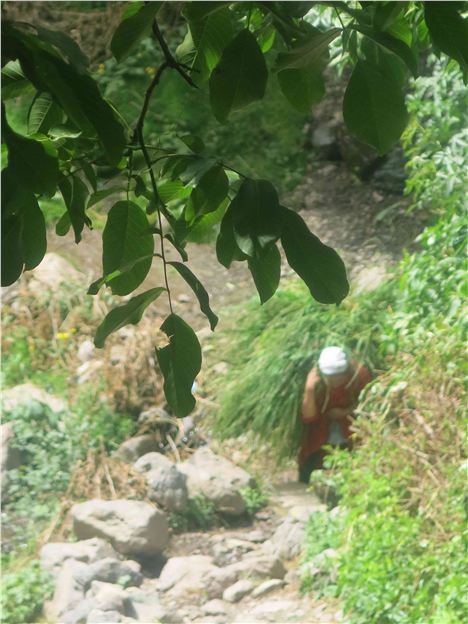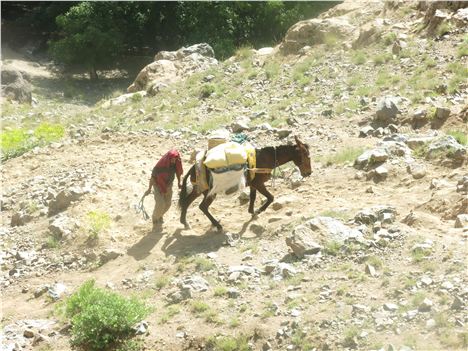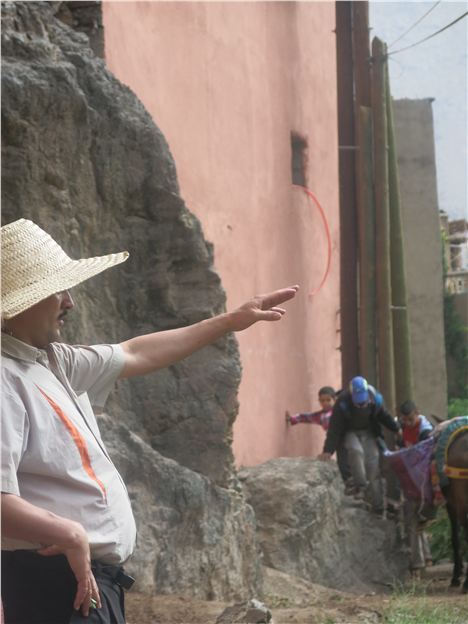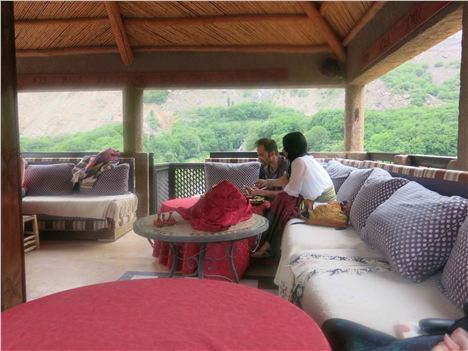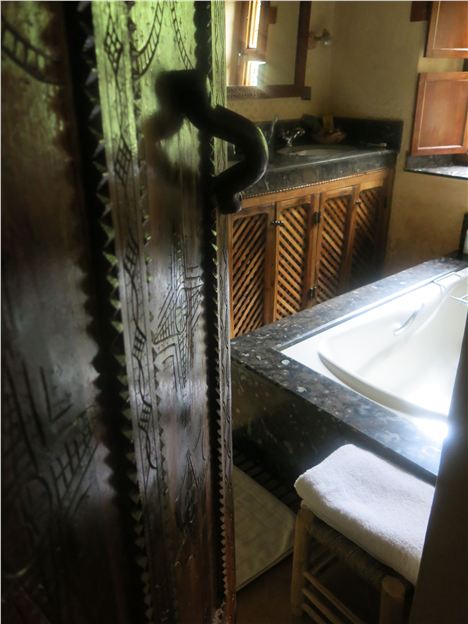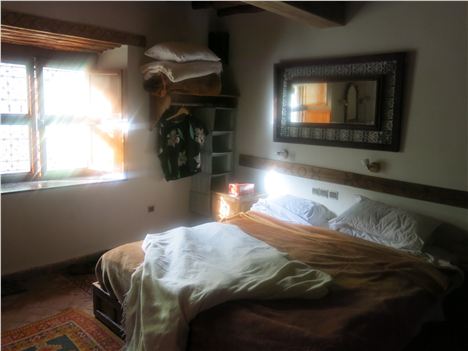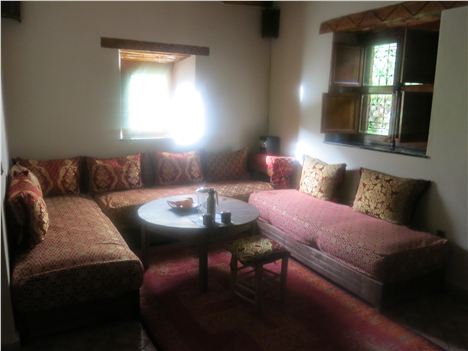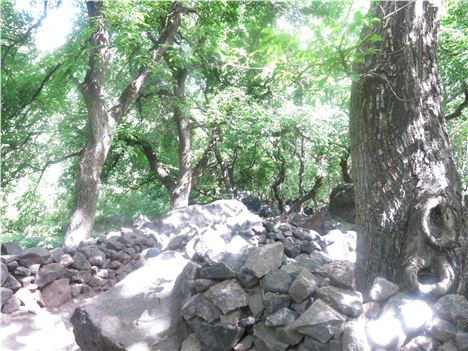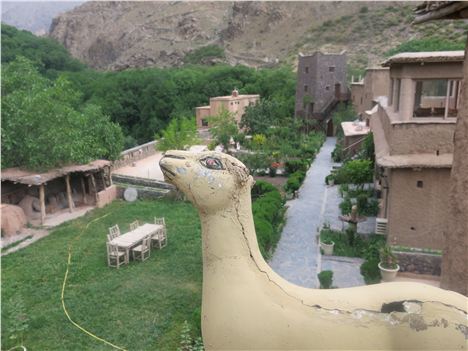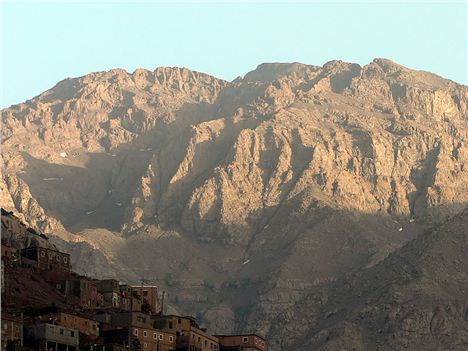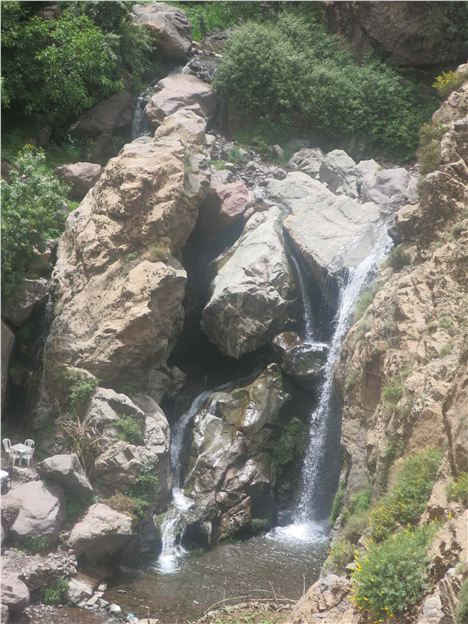“THIS is my sister’s house,” young Mohamed told us. “Please come and join us for mint tea on the terrace.” Our trek guide’s sibling disengaged herself from a gaggle of brightly garbed Berber women to slip into the kitchen out of the dazzling mountain light. The Atlas village of Aroumd is blessed with astonishing views of North Africa’s highest peak at 13,665ft, the mighty Jbel Toubkal. Go higher, to make the ascent, and the rarefied air literally takes your breath away. Quite a contrast to the muggy furnace that is Marrakech only 40 miles south.
'We met cows tethered in small, shaded meadows, a boy herding sheep... and women (who seem to do most of the agricultural work around here) bent double under huge bundles of maize they’d harvested for their animals'
Time was limited. We were happy to occupy the middle ground and amble around the three valleys surrounding our base, the Kasbah du Toubkal (5,900ft). After this impromptu stop on our “introductory walk” organised by our hosts we descended alongside ancient irrigation channels that compensate for boulder-strewn dry river beds. The stone runnels supply the summer sustenance for terraces of apple, plum, orange, apricot and walnut. And, of course, the argan trees that provide the even healthier alternative oil to olive around these parts.
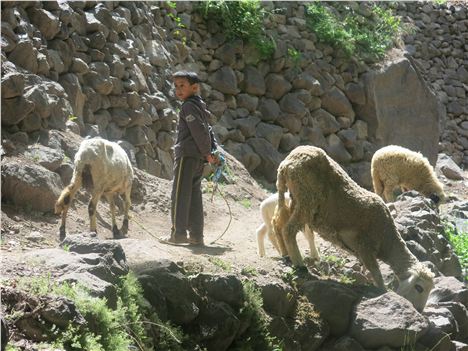 Berber boy leads sheep to pasture
Berber boy leads sheep to pasture
It all made for idyllic walking. We met cows tethered in small, shaded meadows, a boy herding sheep... and women (who seem to do most of the agricultural work around here) bent double under huge bundles of maize they’d harvested for their animals.
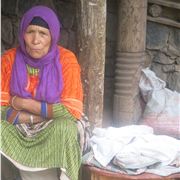 Abashed by our own lack of purpose, save enjoyment of the remarkable landscape, we stopped off at a remote stall for further tea. Inevitably we spent some dirhams – on birthday baubles for our granddaughter back in England and, for me a pair of the traditional soft leather slippers called babouches. Not a real bargain but better value than in the Marrakech Medina. There’s none of the hassle here, either. The mountain folk are not pushy. The Berber reserve shows in a reluctance to be photographed, costumed women and male mule drivers alike. They are a warrior race, who pre-date the Arabs, so it’s worth respecting their wishes.
Abashed by our own lack of purpose, save enjoyment of the remarkable landscape, we stopped off at a remote stall for further tea. Inevitably we spent some dirhams – on birthday baubles for our granddaughter back in England and, for me a pair of the traditional soft leather slippers called babouches. Not a real bargain but better value than in the Marrakech Medina. There’s none of the hassle here, either. The mountain folk are not pushy. The Berber reserve shows in a reluctance to be photographed, costumed women and male mule drivers alike. They are a warrior race, who pre-date the Arabs, so it’s worth respecting their wishes.
Similarly with alcohol. In respect to the Islamic faith, the Kasbah du Toubkal will not supply it to guests. But you may bring your own and take away the empties at the end of your stay. We decided it was a good excuse to de-tox (I’m not a fan of Moroccan wines, which helped).
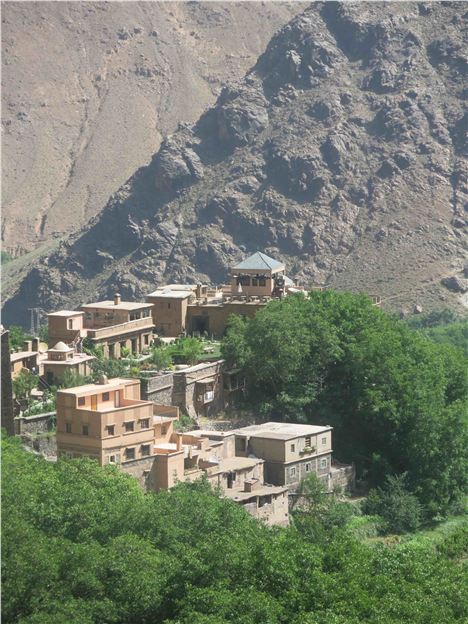 Kasbah seen from above on a walk; this time with guide Omar, below
Kasbah seen from above on a walk; this time with guide Omar, below
This hilltop retreat is all about respecting the traditions of the place. If you want a pampered escape with swimming pool and fancy chef stuff, I’d suggest Richard Branson’s ponced-up Kasbah Tamadot, lower down down the Imlil Valley. Toubkal is different. It styles itself as a Berber “hospitality centre”, not a hotel, and its accommodation ranges widely from bunkhouse to state of the art Garden Suite. Whatever you are paying, though, the point of staying here remains the same – to experience the glory of the mountains and their people.
It’s the full package, not the individual parts, that makes this one of the world’s great retreats. Not all the rooms match the luxury level of the prices; we found the tagine/couscous based cuisine you are committed to because of the remoteness a mite hit and miss; the hamman steam experience is curiously lukewarm; and you might be distracted by raucously rutting feral cats beneath your balcony. So what? Most visitors will find the stupendous vistas ("the best rooftop views in Africa", according to Condé Nast Traveller) and gloriously warm welcome of the native staff ample compensation. We did. And we found more, a longed-for sense of peace.
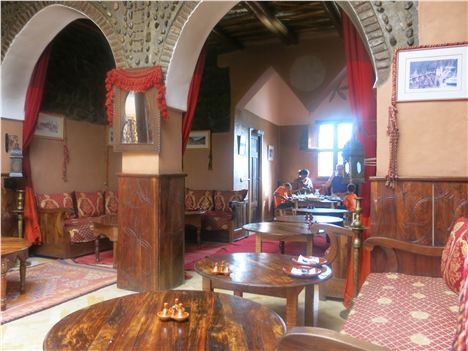 The Kasbah interior; below, its belvedere terrace, perfect for lunch
The Kasbah interior; below, its belvedere terrace, perfect for lunch
Our traditionally furnished two-storey Junior Suite offered babouches, capes and jellabahs to get you into the Berber spirit (plus a very modernEuropean bathroom) and looked down on the wooded river valley and up to peaks and waterfalls.
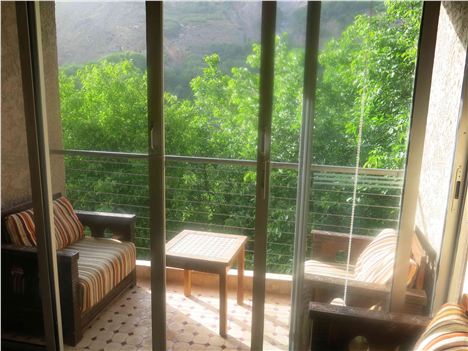 Our balcony; beloe, intricate carving and our other rooms
Our balcony; beloe, intricate carving and our other rooms
It was a wrench to leave this refuge, but it was fun to wander the warren of public rooms, glorious rosemary-scented gardens and rooftop lunch terrace with THAT view. Everything that went into restoring the building back in the Nineties– cedarwood for the hand-carved doors and beams, bamboo for the latticed ceilings, colourful rugs to cover the stone-tiled floors – had to be brought up by mule from Imlil – a steep 15 minute trip.
That’s how our luggage had arrived, too, late evening after our bumpy car ride from Marrakech Airport. We trudged along behind the beast in the pitch black through eerie walnut groves (they gave us torches) to find staff waiting up for us with a three course dinner in the candlelit residence.
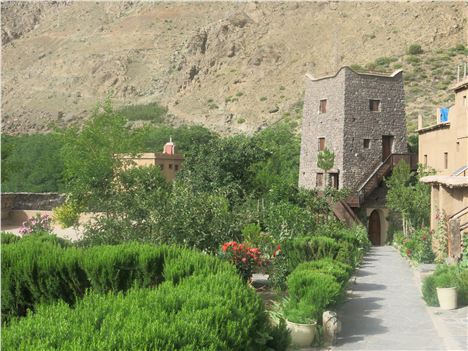 Lush gardens and the Kundun Tower
Lush gardens and the Kundun Tower
It was only in the morning that we really appreciated the Shangri-lalike landscape soaring all around, dominated by the iconic mountain in the distance. The immediate focal point in the garden, though, is the striking Tower tacked on. It’s an essential part of the Toubkal story (read on!), which began in 1973 when 19-year-old Mike McHugo discovered Morocco. Later, he organised treks in the area and befriended the local guide who was to become a partner with Mike and his brother Chris in the restoration of the Kasbah.
It was built in the 1940s as a summer home for Caid Souktani, a feudal baron during the time when Morocco was French protectorate. There’s a picture in the dining room of him and his family with their large white limo. Heaven knows how its suspension coped. With independence in 1956, the Caid quit and the Kasbah was left to its own devices for nearly 40 years until the McHugos, now running the French-based Discover adventure holiday company, began their labour of love.
The aim was always to benefit the local Berber community beyond running the hotel. From eco-friendly cleaning-up of the environment and sustainability to supporting female education, the Kasbah has ticked many boxes, winning numerous awards, including a Green Globe for sustainable tourism. A 5 per cent tax on hotel invoices goes to the Village Association, which has helped provide an ambulance for the area.
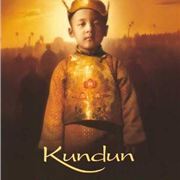 The surprise fairy godfather in kickstarting all this was one Martin Scorsese. He sought a location to recreate a Himalayan mountain monastery for his 1996 biopic about the young Dalai Lama, Kundun, and Toubkal fitted the bill. The McHugos said OK, but the hire fees should go into the self-help projects they were launching. Life was pretty basic in the Imlil Valley then. Electricity only arrived in the valley after Hollywood (the film crew had hauled generators up).
The surprise fairy godfather in kickstarting all this was one Martin Scorsese. He sought a location to recreate a Himalayan mountain monastery for his 1996 biopic about the young Dalai Lama, Kundun, and Toubkal fitted the bill. The McHugos said OK, but the hire fees should go into the self-help projects they were launching. Life was pretty basic in the Imlil Valley then. Electricity only arrived in the valley after Hollywood (the film crew had hauled generators up).
For eight months of the year the snowscapes around the Kasbah are spectacular. Ironically, during filming Scorsese had to resort to using Epsom salts to recreate it on the terraces. The only reminders of the shoot today (the imported Tibetan actors and yaks went home) are a model of a deer on its haunches, set above the main entrance, and that stone Tower specilly consyructed to conjure up a Himalayan fastness. You can imagine the Buddhist prayer flags flutterring from it.
Who needs a movie, though, when you have a landscape in itself a wide screen, Technicolor epic, full of romance and adventure… with the best seat in the house?
Martin Scorsese’s Kundun
Still if you want watch the entire movie visit this YouTube link. It’s rather good and quite underrated.
Fact file
Neil Sowerby flew to Marrakech with easyJet. For more details of their twice-weekly service from Manchester (Wednesdays and Saturdays) visit www.easyjet.com.
He stayed three nights at the Kasbah du Toubkal, Toubkal National Park, Imlil, Morocco. www.kasbahdutoubkal.com.
It is 40 miles by road south of Marrakech, but the last third of the route is on difficult surfaces. The Kasbah arranges transport at around £60 a car each way. Otherwise hire a car at the airport and leave it in the car park at the base camp village of Imlil. The final 15 minute trip up to the Kasbah is on foot with your luggage carried by mule.
There are cheaper bunkroom options, but Standard room prices are 160 euros, Superior 220€, Deluxe 250€, Junior Suite (ours was over two floors) 340€. The Garden House has a 12-metre glass wall and a balcony looking up to the waterfalls and High Atlas mountains.
All prices include breakfast. Soft drinks and mint tea comp throughout the day. Food is simple Moroccan cuisine, tagines and couscous, with a lunchtime set menu for €15, and €20 at dinner.
The Kasbah will organise serious mountain treks to Jbel Toubkal with guides and mules, including an overnight stay in their own lodge in the village of Id-Issa below the summit. It’s a comfortable alternative to camping, offering underfloor heating and three en-suite rooms. Worth booking well in advance.
For bookings within the next two weeks, email kasbah3@discover.ltd.uk or phone +212 5 2448 5611. In the event of no availability or future bookings please ring +33 5 4905 0135. General reservations: +33 5 4905 0135; contact@discover.ltd.uk
Manchester Airport parking:
Neil Sowerby left his car park in T3 Multi-storey Long Stay.
Here are all the options:
VIP Valet – drop and collect your car right next to the terminal and get fast tracked through security. Your car is parked on site.
Meet and Greet – drop your car off with staff next to the terminal and collect on your return. Your car is parked on site.
Multi-storey car park at T1, 2 and 3 – ultra-convenient multi-storey car parking right next to the terminal. Park and walk under cover to reach the terminal.
Long stay car park at T1, 2 and 3 – ground surface car park offering free, regular 24 hour bus transfers direct to the terminal.
Shuttle Park – secure parking at great rates for cost-conscious travellers. Free, regular 24 hour bus transfers direct to the terminal.
JetParks – low-cost parking option run by Manchester Airport, fully manned 24/7, parking from £2.99 per day. Visit this link.







